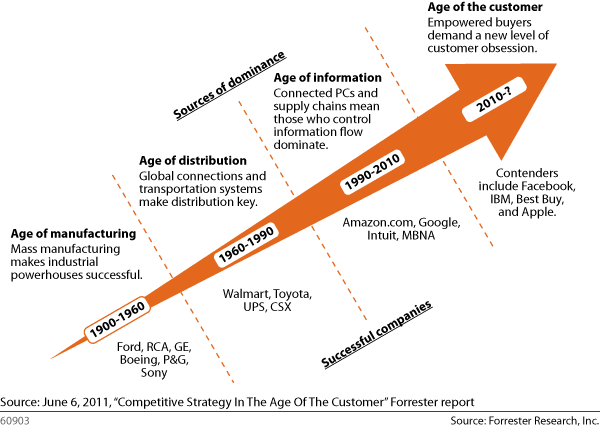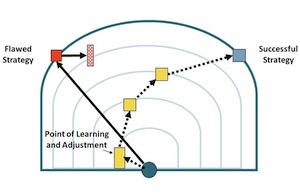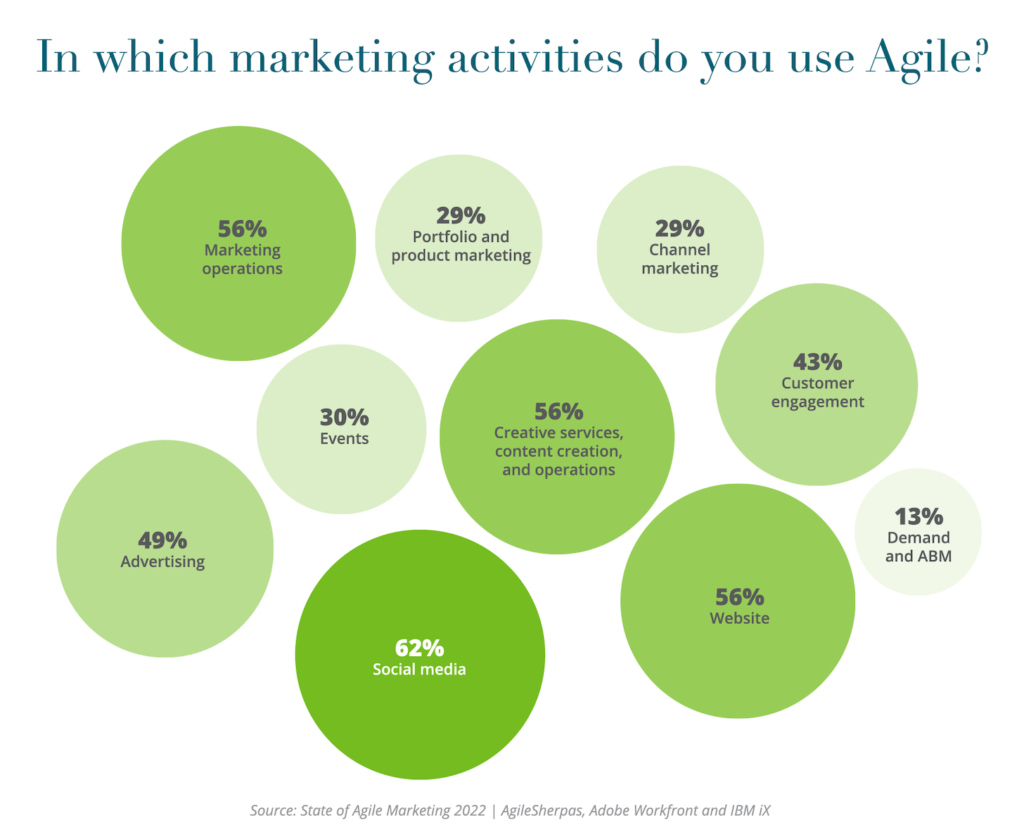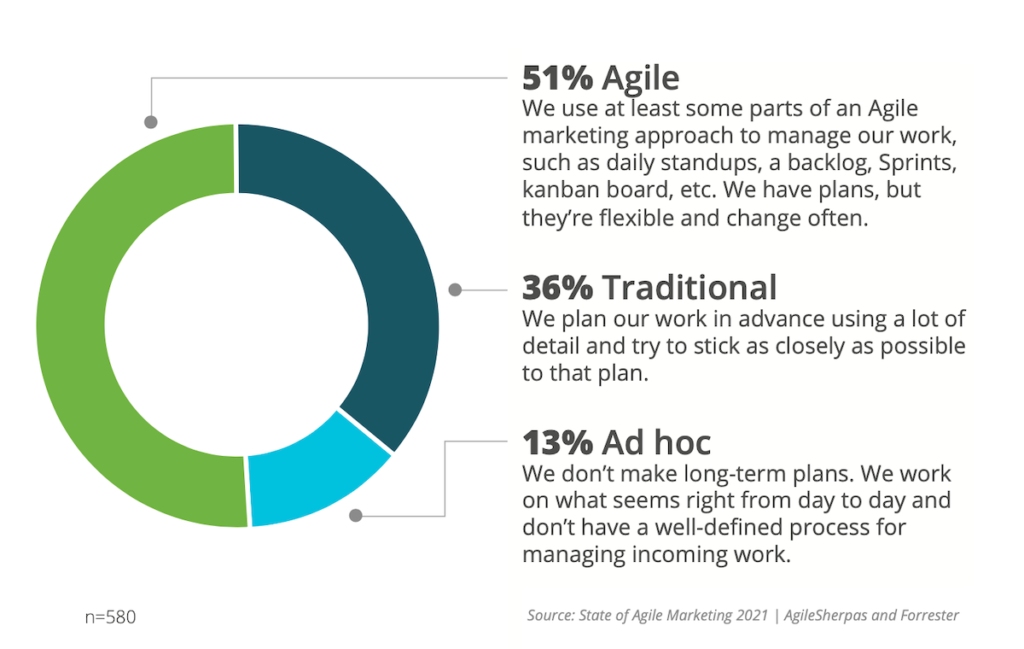You’ve probably been hearing more about agile marketing lately. Over the past 6 months, there has been a blossoming Renaissance of discussions, writings, and events on the subject — a number of which I summed up in a recent Search England Land column, Have You Adopted Agile Marketing Yet?
In a nutshell, agile marketing adapts management methodologies from agile software development (and agile project management) and applies them to marketing teams. It’s also influenced by related movements such as The Lean Startup methodology by Eric Ries.
These techniques are gaining momentum in marketing circles because, in many ways, modern marketing increasingly has parallels with software development, IT projects, and entrepreneurial ventures — in many cases, some of the most important marketing projects these days are software development, IT projects, and entrepreneurial (or intrapreneurial) initiatives.
Yet at the same time, marketing has its own dynamics that make it different than those disciplines. So while marketing can borrow a lot from existing agile and lean methodologies, there’s also a need to modify and extend those approaches into something uniquely suited to the modern marketing mission. A new age of marketing demands a new kind of marketing management.
The above sketch is my perspective on 10 key principles of agile marketing management to consider in the adoption of such an approach in your organization:
Agile Marketing Foundations
Two foundational principles upon which agile marketing is built.
1. Remarkable Experiences. Agile software development puts “working software” as its primary objective — everything else about the principles of agile development is pursued with that purpose in mind.
In marketing, the primary objective is remarkable customer experiences. Are the expectations of prospects, customers, and partners being met (or exceeded!) in the interactions we deliver online, in person, on the phone, over mobile devices, and directly through our products and services? This applies from early awareness building and demand generation efforts through to lifecycle customer service. Because in an age where all prospects and customers are connected through digital networks, everything is marketing.
This focus on customer experience touchpoints is one of the key reasons that marketing is becoming more strategic. Forrester calls it The Age of the Customer. Seth Godin calls it The Purple Cow.
The whole raison d’être of agile marketing is to better enable the delivery remarkable experiences to customers. All of the other principles below stem from this purpose. How can we change the way we manage marketing to be better at this?
2. Responding to Change. Agile management overall is based on the simple fact that projects, marketing, business, life, etc., are dynamic, not static. You make plans, but things change.
The best teams and organizations are able to respond quickly to such change and capitalize on it. It might be deftly handling a social media crisis, leveraging an unexpected opportunity in current events, or simply learning something about your customers or market that was different than you expected (or different than how it was yesterday).
You should still be driven by an overarching vision, mission, and strategy — which provides clarity in how you react to change — but your tactics are adaptive and responsive. It’s the balanced blend of intended strategy and emergent strategy.
Agile Marketing Pillars
Four agile marketing principles that change the game of marketing management.
3. Individuals & Interactions. One of the original values of agile development is the belief that individuals and interactions are more important to success than processes and tools. Of course, processes and tools are valuable — but the contributions and interactions of people are where the real magic happens. Process and tools should enable and facilitate great interactions, not hinder them.
In the context of agile marketing, this has three interpretations:
- Internal marketing operations should be managed in a way that facilitates better interactions between team members, giving them the ability to act and react with greater speed and creativity.
- Collaboration between different marketing and business groups — e.g., corporate marketing, geo marketing, product managers, agencies, sales teams, IT, etc. — should be more open and fluid. Organizational structure can’t be an excuse for failing to deliver remarkable experiences.
- Interactions with individual customers matter. A lot. Thanks to social media, any customer can be a champion or a holy terror. Again, process and technology should enhance — not detract — from individual interactions. This is a huge change in the dynamics of business and marketing, and this new value needs to be deeply absorbed into the DNA of modern marketing.
Getting the balance right between process/technology and individuals/interactions is particularly important with the flood of marketing technologies multiplying in marketing’s ecosystem.
4. Testing & Data. Data is the “star stuff” of modern marketing. It is the digital body language of our audience. We use it to analyze performance (analytics), to uncover new opportunities (data mining), and to dynamically tailor customer experiences (personalization). It’s both the input and output to marketing processes.
Testing has become the quintessential data-driven marketing process: running controlled experiments to determine what resonates best with prospects and customers. A/B testing and multivariate testing are now frequently applied in advertising, email marketing, landing pages, web applications, pricing and bundling, etc. Marketing’s new operational mantra is test, test, test.
Agile marketing uses data for the objective metrics by which to measure the efficacy of marketing activities. It uses testing to engage in continuous improvement. What’s important to us and how do we know if we’re doing better or worse? It makes testing and data an integral part of marketing’s culture.
IMPORTANT: Marketing as a science does not mean marketing is suddenly all left-brain. Real science is a creative endeavor! Data exploration inspires creativity through the discovery of interesting customer patterns. Testing gives us the confidence to try more bold and creative ideas, quickly and with low risk.
5. Numerous Small Experiments. In old school marketing, companies were often forced to make a small number of big bets because the vehicles for reaching customers were primarily “mass media” in nature and had long lead times and high costs to produce. The new digital environment is largely free from those constraints though — it’s feasible to execute very targeted marketing very quickly.
Leveraging the value of testing and data, agile marketing therefore seeks to run numerous small experiments — trying many more ideas at a much higher velocity. As Linus Pauling famously said, “The best way to have a good idea is to have a lot of ideas.” In 2009, Google ran approximately 12,000 experiments, with only about 10 percent of them leading to business changes. But 1,200 proven-to-be-good improvements is impressive. By quickly trying lots of ideas, in a small and controlled fashion, scaling the ones that succeed and jettisoning the ones that don’t, marketing can greatly increase the number of brilliant ideas it “discovers” and deploys.
There is still opportunity for big bets — but now they can be informed by a lot more empirical evidence from pilot experiments that provide “proof of concept.”
6. Customer Collaboration. In agile software development, it’s considered far better to collaborate directly with customers in building a product — iteratively working through designs, prototypes, implementations together — than to get too hung up on specs and contract negotiation at the very start of a project.
The agile marketing interpretation of customer collaboration retains the spirit of working with customers, not merely trying to sell something to them from an abstract market plan. Agile marketing collaborates with customer by:
- Tuning into the voice of the customer, both implicitly from data and testing and explicitly by listening to what they say through feedback channels and social media.
- Engaging with, supporting, and amplifying our best customers who become our champions, advocates, and influencers in the social media sphere.
- Bringing customers into the loop of product/service development — tapping into user-generated innovation — to shape market offerings higher upstream in the organization.
Agile Marketing Essentials
Four essential elements that make agile marketing actually work.
7. Transparency. Agile management methodologies of all flavors — agile marketing included — emphasize a culture of transparency. The individual tasks that people are working on are out in the open, as is their daily progress, and ultimately the metrics by which those investments of time and energy are measured. This openness helps remove impediments, reduce bureaucratic drag, and promote direct collaboration across the team. However, this is probably the single biggest cultural challenge for organizations to address. But it’s what makes everything else in agile marketing possible.
8. Rapid Iterations. In software development, the agile mantra is: “ship early, ship often.” The marketing equivalent is similar. To take advantage of data, testing, and numerous small experiments, it’s important to produce marketing concepts quickly — and where possible, get them out into the real world. You can then iteratively improve them based upon feedback. A popular agile mechanism is the sprint, 1-4 weeks during which the team produces work and then pauses to evaluate and dynamically re-prioritize the next set of iterations. Short sprints rev up the cycle speed of marketing.
9. Feedback Loops. Agile marketing isn’t just about producing a lot of things quickly. It’s about listening to direct and indirect sources of feedback to learn how tests and initiatives are performing, and then using rapid iterations to adjust and improve accordingly.
Every project that marketing engages in should have some sort of feedback metric — quantitative or qualitative — to provide a benchmark by which the team can evaluate iterative improvements. The tighter these feedback loops are, the better.
10. Break Out of Silos! Over the years, marketing organizations have fractured into many different silos to deal with the explosion of customer touchpoints, audience segments, and new marketing tactics. In digital marketing alone, there are often separate teams for search marketing, social media marketing, the web site, email marketing, display advertising, etc. However, customer experiences naturally span these boundaries — and to make them remarkable, these previously independent teams need to coordinate and collaborate at a whole new level. Agile marketing methodologies encourage cross-silo teams to come together on projects quickly and easily and to dynamically reconfigure as needed from cycle to cycle.
For many organizations, adopting these principles will mean adjustments in culture as much as the implementation of specific management techniques. However, in our rapidly changing marketing environment, it’s not hard to see that the single most valuable marketing capability today is agility.
A new age of marketing demands a new kind of marketing management.








This is great.100% agree. Any tools (excluding google products) or resources (i.e. team members) that you rely on to test and deploy?
Great post, Scott and a very comprehensive and well-documented post on key marketing insights. Terrifically laid out with well placed imagest too. Outstanding!
Jeff Ogden, Host
Marketing Made Simple TV
http://www.marketingmadesimple.tv
i have been researching your article for days. great help to me!
可以帮助我向正规军提高,Thank you!
I’ve been hearing about Agile adoption outside the software development industry, but with the exception of the Wikispeed example, this is one of the more detailed descriptions of it. Thanks for the article!
very interesting read Scot, many thanks for sharing. I have worked on Agile Product Management for a while, and soon will be shifting into Marketing, so this links up quite nicely.
Pingback: Why Agile Marketing should become every marketer’s priority